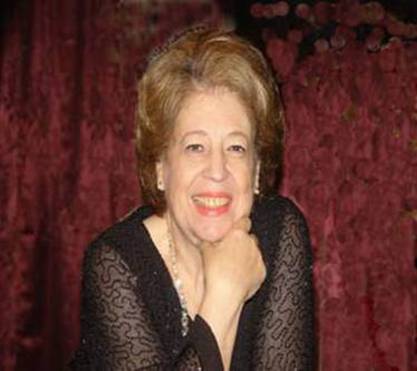Ana Maria Trenchi Bottazzi in Review
“Yes I Can”: A Musical Soirée; Ana Maria Trenchi Bottazzi, piano Stanley H. Kaplan Penthouse, Lincoln Center, New York, NY May 17, 2014
Yes I Can. These three simple words are a declaration by the renowned pianist Ana Maria Trenchi Bottazzi, who has been physically debilitated for the last three years, that she would be the one to decide that she could play and would not give in to her conditions. The May 17, 2014 performance at the Stanley H. Kaplan Penthouse at Lincoln Center was dedicated to Ana Siero de Trenchi, Germaine Pinault, Martin Canin, Drs. Patrick O’Leary, Robert Cooper, Anne Moore, C. Ronald MacKenzie, Edward Rachlin, and the entire Bottazzi family, all of whom helped her to be able to perform again. It proved to be an inspiring evening.
Ms. Bottazzi is no stranger to adversity. I remember when I was twelve years old reading an article in Reader’s Digest (“You Won’t Play The Piano Anymore,” by Robert T. Jones, November 1977) about her car accident, the horrific injuries, and the thirteen year struggle to return to the concert stage. There have also been countless surgeries and other challenges. Ms. Bottazzi was wearing a special back support brace and using a cane as she was carefully escorted to the stage. “It is easier to play the piano than it is to walk,” she quipped. She spoke at length, thanking the audience of her friends, family, students, teachers and colleagues, and doctors for their support. The message of the evening was clear- Ms. Bottazzi is a person who believes that anything she truly wants to do is possible, and she will not suffer any naysayers. Some would say that at this point in her life that retirement would be appropriate, but Ms. Bottazzi will have none of that. Doing what others say is not possible has been the leitmotif of her artistic life.
Ms. Bottazzi performed what was part concert and part spoken autobiography, with sprinklings of anecdotes and wisdom for students, musicians, and non-musicians alike. My personal favorite was advice for the student- “I cannot abide when a student hits the piano in anger. Never, ever strike the piano in anger when you make a mistake. The piano did not make the mistake!”
The first half of the concert featured two works and the life stories that were so strongly associated with these works. It would fill many pages if I were to recount the details of these stories, so I will limit myself to brief summaries. The first story, “Yes, I Can”- Paris Conservatory of Music, told of the young artist in bloom in Paris, and her great reverence for her first teacher Germaine Pinault. TheSonata in C major by Baldassare Galuppi (1706-1785) was the piece selected and it played with a delicate touch and close attention to voicing. It was simple, yet heartfelt. Next, First Encounter with my New Teacher, St. Louis, Missouri, told of a new teacher that she hated prior to meeting Martin Canin on February 13, 1970, and becoming his student. The esteemed Mr. Canin was in attendance and smiled as Ms. Bottazzi shared reminiscences about those days. Beethoven’s Sonata No. 23 in F minor, Op. 57 (the “Appassionata”) was the work that followed. It was played with a great understanding of the dramatic pacing. The Andante was especially moving. One must note that there was something lacking in power, and there were moments of struggle, but considering that it must have been extremely difficult to play while wearing a heavy back brace, one should not be overly critical. As Ms. Bottazzi herself said after finishing, “It was not as good as I can do, but under the circumstances it was quite good.”
After a long intermission, Ms. Bottazzi opened the second half with a premier of Variations from the First Sonata by a composer called “Fuchs”, the first name missing from the program. It was neither Kenneth Fuchs nor Robert Fuchs, and it was certainly not Johann, but he was a Fux, not a Fuchs anyway! After some investigation, I learned it was Helmuth Fuchs. This piece was a good parallel to the Galuppi opening, and was played by Ms. Bottazzi with a similar grace. After this, with the story Going to Miami or Haiti, Ms. Bottazzi regaled the audience about her adventures in an airport that had planes leaving and returning to the terminal in a manner worthy of an “I Love Lucy” episode. Ms. Bottazzi then played Chopin’s Nocturne in E-Flat Major, Op 9. No. 2, in a deliberate manner, slowly savoring each phase and with a delicate touch. My First Encounter With and Welcome to Juilliard told the story of Ms. Bottazzi’s struggle and success as she attempted for three years to gain admittance to the doctoral studies program at Juilliard. The Andante Spianato and Grande Polonaise Brilliante from Chopin followed. Ms. Bottazzi bravely summoned her last reserves, projecting flashes of brilliance despite evident fatigue. The musical shape and feeling were well-conceived, and I am certain that if Ms. Bottazzi were to play this again, it would more accurately reflect her artistry.
As an encore, Ms. Bottazzi dedicated Anatoly Liadov’s Music Box, Op. 32 (also commonly known as Musical Snuff Box) to her mother, in what was one of the more unusual dedications I have encountered. Suffice it to say it was a story of rebellion in keeping with Ms. Bottazzi’s feisty spirit. After the Liadov, Ms. Bottazzi was showered with flowers by a procession of students, family, and friends.

